
The three green skinned races of Raven Islands are not directly related, and unlike various human ethnic groups they cannot interbreed. However they are frequently lumped together because of their skin color, and because they have all arrived on the islands within a 10 year window. Orcs arrived from the west, while Gnoblars and Hoblites from the east in what looked like a coordinated pincer attack on the mainland. It was not. While Gnoblars and Hoblites did have an alliance, Orcs were not involved and they were not even aware another green skinned race landed on the opposite end of the island.
That dreadful decade is now known as The Green Tide and it was one of the most chaotic, but also most important historical periods on the island. The arrival of green skins was instrumental to the formation of the Third Empire and the defeat of the Celestial forces.
Orcs of Orzimar
I’m fascinated by Orcs as a concept. Most fantasy enthusiasts more or less understand what Orcs are, but they still vary quite a bit from setting to setting. Much more in fact than Elves or Dwarfs. Tolkien’s Orcs are monstrous and evil, in Warcraft universe they are noble tribal warriors, in Wahrammer they are slapstick comedy race speaking with Cockney accents and in Ishtar they are hairy ape-dudes. A little while ago I even designed my own version. But for Ravenflight I want to use them a little bit differently.
In most settings Orcs are strong, savage and brutal. That’s what people expect from them. So to subvert this, I want to make Ravenflight Orcs to be civilized, noble and orderly race. They will be the knights, and paladins of the setting.
In D&D terms I would say that these Orcs are almost always lawful good. Orzimar is one of the most orderly and well governed provinces on the Raven Island. Instead of being savage brutes, most Orcs are actually rather distinguished, law abiding and deeply religious. Their faith is a bit esoteric and full of complex mysticism which makes it difficult to explain to the outsiders. At the most fundamental level however it is fire worship. The practitioners of this religion view flame as a metaphor for their own souls. Fire is a destructive force, which if left unchecked devours everything in its path, and such is also the nature of the Orc soul. The faithful believe that their minds and bodies were forged in battle to be world’s most dangerous, efficient and uncompromising fighting machines. In the past Orc war bands would spread across the land like forest fires, conquering and destroying civilizations and leaving only smoldering ashes in their path. The Temple of Eternal Flame was established to curb these violent urges and re-focus them on something positive. Fire, despite it’s destructive potential can be used to forge complex tools, cook meat to feed the hungry, cauterize the wounds to stop bleeding and etc. If controlled it is a force for good, and so is the Orc civilization under the rule of The Temple.
The Eternal Flame that burns on the temple altars also functions as a sort of meta-deity which is basically a union of all Orc souls, both living and dead. Faithful pray, or rather meditate while gazing at flickering flames to attune themselves to that meta-community and potentially receive guidance from ancestors who are not really ancestors but rather conduits of the meta deity. A deity without a will or persona of it’s own, but which represents the will of the Orc people everywhere. Orcs can ramble about their faith for days, slowly peeling layer after layer of mystical dogma. Functionally however it basically means that Orzimar is a theocratic society.
The priests of the Temple are not only spiritual leaders, but also the ruling caste. The idea is that Orc civilization functions solely thanks to their religious dogma which allows them to channel their violent urges. Thus the theologists most versed in said dogma are most suited to be leaders. Instead of letting the nation be ruled by the strongest and most savage warlords the power is instead given to those members of society who are wise and posses the most self control.
In modern Orc culture praises stoic detachment, non-violence and wisdom. The Temple has developed strict code of conduct all the faithful try to abide by. Other races often refer to it as a “honor code” but in the Orc language its name actually translates to “code of personhood”. The code basically describes not what is virtuous, but what is the absolute bare minimum of decency one has to exhibit to call themselves a civilized person. The code it is actually long and nuanced, but in general it proscribes truthfulness, loyalty, keeping one’s oaths, using violence only when necessary, protecting the weak and not giving into emotions.
Orzimar is ruled by The Grand Theological Council based in The Temple City, which consists of three arch-priests chosen from among the most distinguished temples. They are the highest authority both on the spiritual dogma, as the law of the land. From them, the power is delegated to individual temples, each of which oversees and provides guidance to one of Orzimar’s many provinces. Each temple is lead by priests and arch-priests and protected by Temple Guards (or Templars) who act both as the local police force and military. Becoming a templar is considered a great honor and reserved only for the most distinguished citizens. The priests and templars are the functional elites.
There also exist another prestigious caste within the Orc society. Their name is usually superficially translated as “knights” or “lords of the realm” but it actually also means “those whose blood is fire”. They are those orc families who can directly trace their ancestry to infamous warlord clans that once ruled the Orc people. Even though these ancient rulers are now primarily considered to be uncivilized and villainous their are still held in great respect by the common folk. Because of their lineage, the Temple tradition forbids them from becoming priests or templars. To earn their loyalty, the Temple makes many concessions to offer them special social status. The fire-bloods can for example own land if they can afford to purchase it. Each temple must allocate a percentage of their holdings and make it available to any noble-born Orcs who can make a valid claim. They are also exempt from most taxes and temple fees.
As a result most of the Orc knights are affluent and influential. They typically style themselves as scholars, merchants and deeply religious individuals to distance themselves from their ancestors. The temple considers them to be a pain in the ass, but also a useful resource if they play ball. As secular men and women who are often hero-worshiped by the local peasants they can often sway the popular opinion and aid spreading temple dogma.
During war time, the lords typically take up arms, and pledge their services to the local temple riding to battle alongside the templars. But while templars always carry banners and insignia of the Temple, the fire-blood knights are allowed paint their ancient family clan markings on their shields. During peace, they often organize jousts and other martial competitions.
It is important to note that fire-bloods are not Orc aristocracy. They have no official political power and as far as the Temple is concerned they actually are lower on the social ladder than ordinary commoners. They however enjoy status of folk heroes and local celebrities. They are are beloved, despised, gossiped about and their lives, romances and exploits are closely followed by the public. They are the rock-stars of the Orc society, by birth right. Their opinions and can sway the masses.
The actual aristocracy, with power and political sanctions are priests and templars. Priests are the ruling class. The life of a priest however is not one of luxury. Priest must commit themselves to a regimented Temple lifestyle, and follow even stricter codes of conduct. Their life is filled with ritual, and tradition and they must forgo personal goals and desires, instead submitting their will to that of the Temple. Priesthood titles are not hereditary, and those seeking to join the priesthood must start as a novice and move up the ranks.
Templars are the functional aristocracy. They are given land holdings from the Temple in exchange for their military service and they are free to govern said fiefdoms as they please (but under the oversight of the Temple). They are the local governors and overseers. The templar titles are given out by the Temple priests but not hereditary. While it is common for children of templars to become templars themselves, they still must apprentice as squires and distinguish themselves to earn the title.
Orc society is far from being homogenous. Many of the lands in the Sought Western part of the nation used to belong to the Third Empire and are still home to large number of humans both of Imperial and Armadan descent. While the human settlements are officially under Temple rule, Orcs typically let them self-govern and do not meddle in the human affairs, unless they are actively going against the dogma. To Orcs, humans are an inferior and weak race, so the Temple feels compelled to delegate templars to protect and police their villages. These specialized squads however are typically trained to consult village elders, and help them enforce common human law, unless it contradicts the Temple proscriptions.
Humans are more than welcome to convert to the Orc religion, but they are not allowed to become priests or templars. They can however serve as squires to the Temple Guard which is actually a very prestigious position for an Orzimar human. Orc squires are typically expected to eventually be promoted to fully fledged templars. The fire-blood knights typically retain no squires, but instead have Ravenkin servants who saddle their horses and/or maintain their armor.
While most Orcs have green skin, there exists an ethnic minority within Orzimar whose skin has a grayish tint. They are on average taller, and bulkier than the green Orcs but those are mostly superficial differences. While there are no rules prohibiting Gray Orcs from joining the priesthood or becoming templars they almost never do. There seems to be a good deal of prejudice against them in the Temple because most Gray Orcs are followers of the Old Faith. In addition to following the teachings of the Temple, they also worship the ancient Orc pantheon of deities lead by a fearsome god of thunder. Many tattoo blue lightning patterns on their skin to honor said deity.
The Code does not prohibit polytheist faith, but most priests consider the Old Faith to be savage, uncivilized and incompatible with the modern teachings. Very few green Orcs choose to follow that tradition. Gray Orcs have even lower social status than fire-bloods, and they don’t enjoy their privileges. They are considered an undesirable underclass by most. That said, they proud traditions of craftsmanship and some of the most renowned smiths, potters, woodworkers and artisans are Gray Orcs. Many fire-bloods and even templars seek out their services or even retain them at their courts. There have been occasions when Gray Orc squires were promoted to full fledged templars, but only after renouncing the Old Faith.
Within the Temple there exists a secretive order of mystics known only as The Faceless Monks. They wear blue robes, and silver face masks to conceal their identity. In order to join that order, one has to renounce any and all personal identity, and fully commit themselves to the faith. They are rarely seen outside of the Temple City where the order has it’s headquarters. The Temple has seven holy texts, each of which reveals more intricate, mystical secrets of the Eternal Flame. The first three books outline the core tenets of the faith that are taught to everyone. Those who wish to become templars must familiarize themselves with the Fourth Book which outlines the duties of a Temple Guardian. The Fifth and Sixth Book outline duties, sacred rights and provide mystical revelations for the members of the priesthood. Each of the books is progressively more abstract, and harder to read. Temple novices spend years learning how to interpret the teaching of the Fifth and Sixth book. The Seventh Book is a complete mystery, written entirely in a metaphorical cipher. Reading it has driven ordinary Orcs insane.
Faceless Monks devote their entire lives to study of the Seventh Book. They act as advisers to the Grand Theological Council on the matters of faith, but may not become councilors themselves. The common belief is that these monks understand the innermost workings of the Orc soul. They know how to persuade, change people’s opinions simply by choosing the right words, or modulating their voice a certain way. They can give orders that cannot be refused. They are said to be mind-hackers – the Bene Gesserit of the Orc kind. They are feared by the common folk, and seeing them outside of the Temple grounds is considered a bad omen.
When Orcs arrived on Raven Island they did not come alone. They brought Ogres with them. These towering giants are about twice as tall as the largest Orc, and about as wide. They are incredibly strong and tough, but are said not to be very bright. This is actually not entirely true. They have been proven to be just as intelligent as humans or Orcs. People assume they are dim-witted mostly because Ogres have trouble developing good social skills.
They are thought to share a common ancestor with Trolls, and like them they are introverted and contemplative species. Most Ogres prefer to spend their time alone, and get together only to trade, exchange information or mate. Most Ogres will talk with their closes friends once or twice a month at most – anything more would be rude. They also don’t have concept of greetings or good byes. They simply walk up, start a conversation and they leave when they get bored. While they can be taught local customs and manners it usually takes a while for them to understand why such things are even necessary. Some Ogres do make an effort to learn and follow local etiquette, and even attend Temple masses and study the holy scriptures in their free time. Many however don’t bother, and only interact with locals when they need something often cumming off as rude, ignorant and clueless – hence their reputation.
In Orzimar they typically live outside villages or smaller settlements and trade with the local population. Because they typically do not form their own communities, sometimes it seems like almost every Orc settlement has their own Ogre or two. The Ogres are usually happy to help the villagers out with heavy lifting or hard labor, provided they don’t have to do it too often. They are also fearsome fighters and many fire-bloods like to include them as part of their retinue.
Gnoblars
A lot of people liked the ideas I had in my Goblin post, especially including the “social network” concept. For Ravenflight I decided to embrace and extend that idea, liberally borrowing from Vernor Vinge’s Fire Upon the Deep novel.
Gnoblars are the smallest of the green skin races – shorter even than the diminutive Ravenkin. They have disproportionately large heads with big mouths and small red beady eyes. They are known for constantly fidgeting, and making small noises. They are also frequently refereed to as Goblins or Swamp Things. They are possibly one of the most poorly understood species on the Raven Islands.
A single Gnoblar is about as intelligent as a dog or a cat. It is mostly operates almost entirely on instinct, though it seems to have enough intelligence to dress itself and use simple tools and weapons it is carrying to hunt or defend itself. That said, is mostly incapable of comprehending speech or following instructions. Experiments done with mirrors showed that Gnoblars are profoundly confused by their reflections, and constantly try to interact with them.
Once you get two or three Gnoblars in the same roo, they start making high pitched, chittering noises and suddenly they seem to get smarter. Gnoblar triplets understand mirror reflections, understand speech and can respond, though their speech is typically limited to monosyllabic words, grunts and gestures. Typically they choose a single “speaker” among themselves who is in charge of vocalizing for the group, though they always seem to discuss what is to be said in their fast, high-pitched squeak-speech.
The optimal number of Gnoblars seems to be somewhere between five and ten. That’s where they start being capable of speaking in full sentences, building new tools, casting magic spells (typically via dedicated caster member of the group if one is available), picking locks, setting traps and etc. When Gnoblars march to war, they typically operate in small squads of ten individuals, and they can be brutally efficient. The entire squad tends to act with a single-minded precision, each member fulfilling a role of an extra limb or an extra pair of eyes.
When they are in a group, their minds seem to switch to a kind of parallel processing mode, and the information is exchanged via the chittering sounds they make. It does not seem to be a traditional language, but rather a data-exchange protocol or some sort, and as such it is entirely untranslatable. Gnoblars seem to be born with the ability to understand and make these sounds, but they must learn human speech. The knowledge and skills seems to be transferable between individuals, though it is never a perfect transfer. For example, a Gnoblar who is very good at basket weaving can “pour” all the knowledge on that topic onto another individual. This does not however mean that the new Gnoblar will be just as good at it – she will have all the knowledge about it, but not necessarily the manual dexterity and muscle memory required to perform the skill.
This is one of the reasons why Gnoblar technology typically seems rather shoddy and of poor quality: because everything they make is typically built with unskilled hands, based mostly on second hand knowledge.

Gnoblar Dublet – these individuals probably got separated from their group, and so they reverted to basic hunter-gatherer instincts trying to survive long enough to be picked up by another group.
Individual Gnoblars seem to be considered worthless. Some are valued more than others: for example, Gnoblars capable of channeling magic, or those who are very good at specific skill to be valued more than the others. They are still expendable, because their skills are fully transferable and it will only take time to get other individuals to the same level of proficiency.
In general, the more Gnoblars participate in a group, the smarter it gets. There seems to be an upper limit on this. Because they exchange information via sound, groups larger than fifteen or twenty individuals tend to “think” much slower, because they can’t all talk at once and it takes time for the information to circulate amongst the group. While it is not uncommon for Gnoblars to have communal “thinking” sessions that involve hundreds of individuals, they tend to operate best in groups of about dozen individuals. The composition of such groups is almost entirely fluid: Gnoblars readily swap members between groups both to gain new skills, as well as new information. Instead of gossiping for example, Gnoblars will “load up” one of the members of their group with all the relevant information and send it over to the neighbor, who will in turn send a response “packet” in the same way.
Gnoblars tend to view themselves as a single entity – a group mind that spans the entire territory of great swamps on the border between The Third Empire and the North End. Individual Gnoblars do not seem to have names, and are mostly confused when queried about their identity. When asked “who are you?” they will usually respond “We are Gnoblar.” and leave it at that. They do however seem to understand that other races operate differently. They understand that a single human is a complete individual who can’t meld with a group or exchange information the way they do, but they are on record saying such an existence seems to be terribly lonely, sad and frightening to them.
For many decades Imperial scholars insisted that Gnoblars were religious, because they would frequently refer to them by name and in the third person. For example, a group of about dozen Goblins who was frequently trading with Imperials would often make statements like “Mork would sell that for less than 3 silver coins.” When queried about identity of Mork, they would only say “We all is Mork” or “Mork is many Gnoblar”. Other than such statements however, they never indicated any signs of religious worship. In fact, most Goblin packs seem to be rather confused by the concepts of religion. Only recently has it been established that these names were actually indicators of group identity.
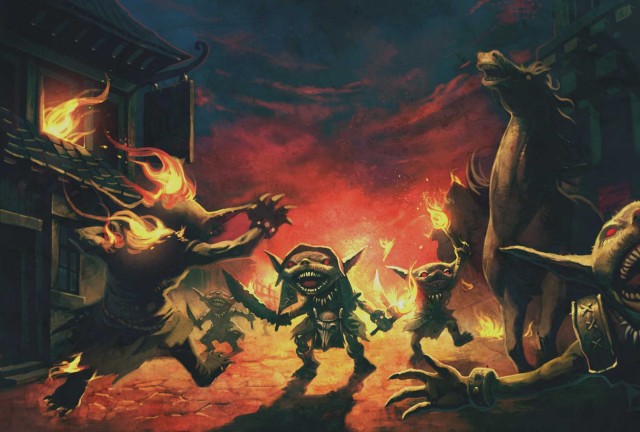
Individual pack members are expendable. Note how Gnoblars do not react to the individual being on fire.
While individual Gnoblars have no names, a pack of a dozen of them will over time develop some sort of individual personality. Each pack seems to choose a name to signify themselves, and they usually refer to that name in the third person when interacting with other races. The “personality” of a pack seems to fit neatly in the head of a single goblin, but can only manifest its will when there is about ten to twelve individuals available for processing. This means that every member of the pack can carry the “soul” of the pack, and as long as one of them survives the pack can be re-constituted with new members. A Gnoblar can carry the “soul” almost indefinitely, but if he joins a pack which already has a “soul” he can be compelled to forget it. It is basically up to the new group to decide whether they want to retain it or erase it, as the individual Gnoblar will have to comply with overriding group wishes. I most day-to-day interactions, Gnoblars used as “data packets” get blanked and assimilated once their information is extracted. However, sometimes a pack will donate a few members of their own to “resurrect” a fallen comrade whose single member has survived.
The average lifespan of a Gnoblar is between ten to fifteen years, but a pack “soul” can actually live indefinitely. There for example, there still exist packs who fought during the Green Tide events. It is however frowned upon when packs get too individualistic and self serving. When a group of Gnoblars starts to go against the wishes of the majority, it’s members will typically be separated and assimilated to other packs erasing it from the existence. Gnoblars don’t really think of this as death, because memories and skills of the members are retained. The “souls” are viewed as a side-effect of the way Gnoblar minds work, and indulging them is considered ill-advised. Gnoblars adopted the human word “pervert” to describe Gnoblar packs who leave the mainstream society to pursue individualistic hopes and dreams. It is those perverts who are commonly seen traveling through the Empire, Orzimar or signing up to be Armadan ship crews.
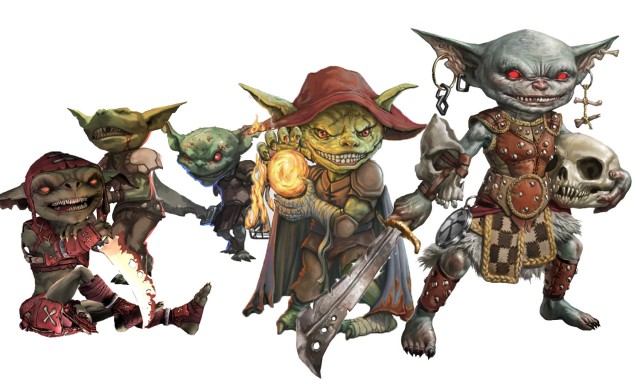
Part of a Gnoblar “Pervert” pack. Note skin discolorations, lesions and other ailments caused by inbreeding within the group.
Gnoblars reproduce sexually, but have very little sexual dimorphism. Gnoblar women look almost exactly the same as their men, with the exception of genitals, and the twelve teats on their abdomen. They usually give birth to litters of about six to twelve children who reach full maturity in roughly a year and a half. In the mainstream Gnoblar society, packs constantly shuffle members around so they always have genetically diverse breeding pairs available to them. The traveling perverts unfortunately have no such luxury, and therefore they typically in-breed within the pack. This is only sustainable for few generations before the lack of genetic diversity starts to cause birth defects and health issues. Most are afraid to visit Gnoblar settlements out of fear of being disassembled and assimilated so they rarely have access to fresh blood. Some perverts become bandits and they will attack Gnoblar traders and kill enough pack members to be able to assimilate the survivors. Those who choose not to do this typically get progressively weaker, and eventually become completely incompatible
Gnoblars have peaceful relations with the Third Empire and North End. They frequently trade with humans and they allow their trade caravans go through their territories, though they tend to tax them. Gnoblars actually started building roads through their swamps to facilitate trade between Empire and North End and reap the benefits of the traffic going through their territories. They are shrewd traders and reliable workers. Humans actually prefer to hire Gnoblar laborers, because unlike Ravenkin they are trustworthy and reliable. That and any Gnoblar pack seems to feel compelled to repay debts or appease for the faults of any other pack.
Hoblites
Now that I turned Goblins into this weird, somewhat cute and cuddly hive-mind like race, I still had a lot of artwork in my research folder that depicted goblins as these cool looking, ugly, gaunt green dudes. I like these guys, so I figured I would make them a playable race. I didn’t want them to be automatically evil. That said, I didn’t want them to be as honorable and awesome as the Orcs. I wanted them to not be evil, but still be kinda messed up in some ways. But it had to be for a reason, and “chaotic neutral” is not a reason to me. It had to be something else.
During the Green Tide, Hoblites were commonly refereed to as Hobgoblins. Humans and Orcs assumed they were simply larger Goblins, but that is not true. Unlike Gnoblars, Hoblites are not group minds but rather individuals and they consider their smaller cousins to be an inferior race. They worship the Great Hob who is their patron deity, and who was said to have two brothers Gob and Nob, each of whom was born with half a brain. Those intellectually impaired brothers went to create the Gnoblar race, while Hob became the patron of the Hoblites.
Hoblites are taller than Goblins, Ravenkin and Dwarfs but shorter than most humans. They have a green skin, though the actual tint seems to vary from deep green to almost grayish blue. They have large ears and noses, but their mouths remain proportional unlike the large maws of Gnoblars.
Compared to other races, Hoblites have very short lifespans. Most of them die before they get to their mid twenties. Hoblites surviving into their thirties are about as rare as humans living into the hundreds. Unlike Gnoblars who reach full maturity within a year or so, Hoblites have the long childhoods of most sentient, self aware races. They are physically and psychologically immature for roughly the first eight years of their life. This leaves them very short window of opportunity to accomplish their goals, find happiness and etc. This is reflected by their culture which is very focused with the present.
Matt` in the comments aptly pointed out that this gives Hoblites on average a 10 year span of time to accomplish all the things which leaves them with little to no time to actually reproduce and rise children. How does this work then?
Hoblites actually practice communal child rearing to free up fertile members of the society to pursue other tasks. Each town or village has one or more Foster Halls dedicated to care and education of children. They are staffed by the order of Fosterites which is an ascetic scholarly order devoted to education and social care. Chief among them are Foster Sages who administer primary education and philosophy classes for adolescents 6-8 years old.
Children are organized into what is known as Kiths. Each Kith consists of about 30-40 kids of roughly the same age, under the care and supervision of Foster Matron who is responsible for their immediate needs, and care. Kith-mates stay together, playing, learning and working as a group until the age of 6 when they get to pick an education path based on their interest under the tutelage of Foster Sages, or choose to apprentice in a local guild. When they reach the age of 4 which is roughly equivalent of human teenagers with respect to emotional maturity, they are expected to help out with care of younger children. Each Kith is assigned a younger Kith they help out with. A member of your own Kith is a Kith mate, while a member of the Kith you were assigned to help out with is a Kith sibling.
As a result of the Foster Hall system nearly all Hoblites are literate, which is unprecedented among Raven Island societies. The system also creates a complex web of social relationships and dependencies within their society. Bonds between Kith mates are incredibly strong (often considered stronger than blood relations). Hoblites tend to have extensive support system: at any given time a child can seek help or advice from one of it’s blood-parents, a Kith matron, a local Foster Sage, one of the two dozen Kith mates, one of the elder Kith-sibs or one of the younger Kith-sibs.
When introducing themselves Hoblites will usually mention their Kith and Clan in that order and Kith rivalries or Foster Hall grudges play a huge role in their social lives and politics.
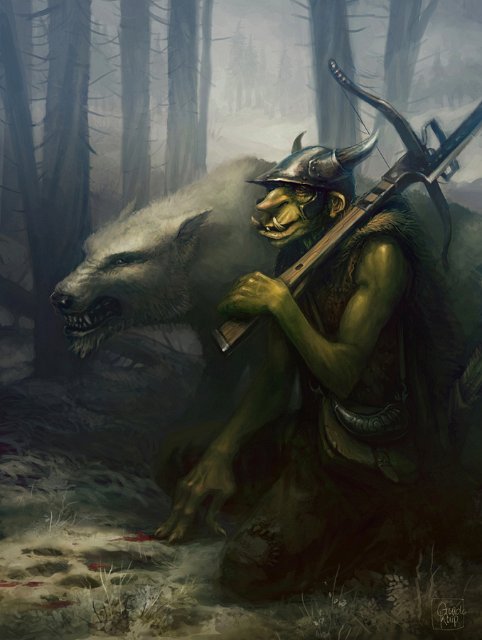
Hoblite Ranger and his riding wolf. The rider and the pup usually grow up together, age and die around the same time.
Hoblites are people who live in the moment. They are very much focused on doing things now, never putting things off until later, and accomplishing their goals. They are extremely drive, overly ambitious, and praise self reliance above all else. Selfishness is not considered a vice but a trait integral to Hoblite personality. Think Ferengi, but without the obsession with profit. The Hoblites are good merchants, but their life philosophy does not revolve around trade and acquisition. It revolves around fulfilling their own dreams and goals against all odds. Compassion and empathy are considered to be weaknesses that can and should be exploited.
Hoblites view themselves as better adjusted, more driven and more successful than all the other races. To wit, they have one of the most efficient trading networks on the Raven Island, and some of the most accomplished magical institutions.
The Hoblite Warlock Covens are famous throughout the islands for their skill and their collection of ancient scrolls of magical lore. Most warlocks can actually hold their own in magical duels with Armadan aristocracy, which is impressive considering the Capitol mages perfect their craft over many decades of study whereas Hoblites don’t even live longer than twenty years. Their accelerated programs of study attract many Imperial men, Nords and sometimes even Savage Dwarfs and Centaurs.
The Land of Hob is a feudal monarchy led by the Hoblite king. The capitol city is located on the easternmost penisula known as the Dragon’s Tongue. The tip of the Dragon’s Tongue is the location of Kingstown – possibly the largest and most populous metropolis in the Raven Island. It is a sprawling hive city which is home to seven rivaling Warlock Covens and the King’s Castle carved out of a gigantic petrified mushroom.
All Hoblites are subjects of the King and while the power is hereditary the throne is rarely held by a single dynasty for more than a few generations. Many kings are simply to busy trying to achieve greatness to sire children. Unpopular kings tend to get themselves and their families assassinated rather quickly so the power changes hands rather rapidly. New laws are established, nullified and changed all the time, and other races often have trouble keeping up with the court affairs of Kingstown. Most of the time the politics of Hoblites are an exercise in barely controlled chaos.
One of the other interesting locations in The Land of Hob is The Pitt. It is a big city located in the Southern part of the nation, on the foothills of Shadow Peaks. The city is built around the volcanic lava flows, and mostly carved out of stone. This is in a stark difference to the usual Hoblite architecture which involves wooden houses, or abodes carved out in the giant mushrooms they have transplanted to Raven Island from their homeland many centuries ago.
The Pitt is the home to the eight most powerful coven in the Land of Hob (the first seven being Kingstown covens), which is actually almost entirely dominated by Ravenkin mystics. They have actually used all the Hoblite rapid learning techniques and applied them over their longer lifespans to become some of the most powerful Warlocks in the land. It is a mecca for all kinds of social misfits: a town full of Gnoblar perverts, Ogres, Gray Orcs, Imperial men seeking to make name for themselves and etc. It is almost a micro-nation, ruled by the Ravenkin elders. Officially the citizens of The Pit are subjects of the King, but the King’s law doesn’t really apply in the city which is why it attracts so many misfits and criminals. It is where Imperial men and Hoblite women come to feel empowered. It is the only city in which Ogres are allowed to study magic and Gnoblar perverts can go to find new breeding members without fear of being erased from existence. It is also the only city in which Ravenkin are actually allowed to hold position of power.
Because The Pit is such a multicultural melting pot, the Hoblite citizens tat live there are actually much less selfish and more compassionate than anywhere else. In fact, the general culture of The Pit is starkly different from the mainstream Hoblite culture, emphasizing equality and compassion. In The Pit all races and genders are considered equal, and have equal access to education and resources.
Throughout the rest of the Hob Land however, the society is definitely very patriarchal and quite prejudiced against everything and anything that does not conform to the Hoblite ever-changing standards. Hoblite women are not allowed to hold political positions or study magic. Other races are usually treated with disdain, and often persecuted and exploited. Non-Hoblite men (or creatures that can pass for men) can join covens and study magic. The exception are Ogres who are considered to stupid to learn any spells, despite ample evidence to the contrary. For the last 40 years there was also a law on the books that forbid Orcs from studying magic though no one really knows why. It is said that the king who established it simply didn’t like Orcs. So far no one bothered to question or remove this law.
The fact that Hoblite women are not legally permitted to study magic, doesn’t mean that they do. The Pit covens are open to both men and women, but not everyone is capable of traveling sought, or can afford to live in that crazy upside-down city. Therefore there exist secretive Witch Covens. They are usually established far outside of major settlements in secluded areas.
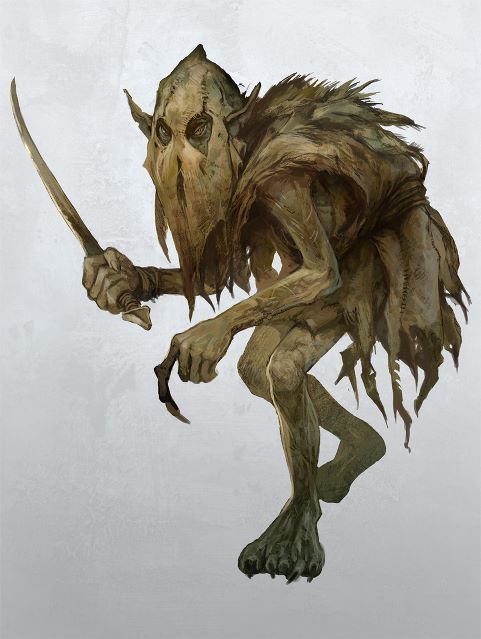
Hoblite Witch wearing a mask and ragged clothes both to to protect her identity and to play on the folk fears of the “stereotypical witch” imagery.
Witches typically wear masks to protect their identity when they go to their meetings, and blend back into the mainstream society the rest of the time. These covens also double as a sort of feminist organizations that help to empower Hoblite women and educate them not only in magical arts, but also discuss politics and ways to make Hoblite society more egalitarian.
One of the most prominent and established Witch covens is located at the Cursed Hill in the North, near the border with the Third Empire and the Black Forest. The witches themselves call the place Moonlight Falls. It can be frightening to outsiders, and witches prefer to keep it that way to avoid being harassed. Poor and downtrodden Hoblites will often seek out the Witches of Moonlight Falls because unlike Warlocks who work only for hard cash, Witches will often offer their services in exchange for favors or promises which need to be repaid later. Failing to repay such a favor is usually a very bad idea.
While the Warlock covens compete against each other, Witch Covens collaborate and exchange knowledge. In fact the Witch Coven network extends from Moonlight Falls all the way down to The Pitt. The covens will often take in battered or mistreated women, or provide transportation and lodging for those who wish to travel into The Pit or leave the Land of Hob.
Being a witch carries a very huge social stigma. Witches are feared and despised and often persecuted for their craft, which makes them distrustful toward strangers. Hoblite legends usually feature evil witch as the villain and a heroic prince or axe brave as the protagonist. In Kingstown and the Dragon Tongue region Witchcraft is persecuted by public flogging and/or heavy fines. It used to be punished by death, but then the law was reversed when the king’s own sister was found to be a witch. In the North-Western regions of the country almost all women are somehow connected to some sort of a coven. Even women with no magical talent or interest in magical arts attend meetings to discuss politics and equality. This is considered to be a “bad” influence of the Imperial culture, and the locals just accept it.
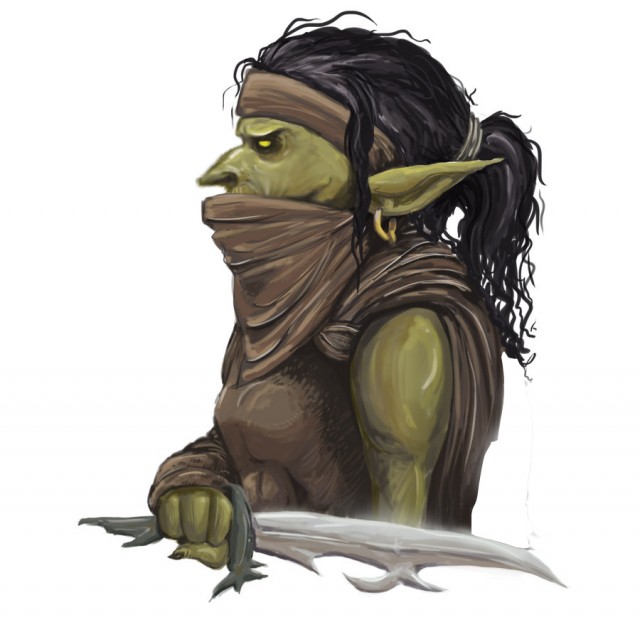
Hoblite Warrior-Witch. Since local men will sometimes try to break up coven meetings, many women become self-appointed protectors an enforcers who patrol the area, and try to fend-off attacks.
The Hoblite culture has rich legeds and stories, most of which feature a cast of archetypal heroes and villains. The most common antagonist is an evil witch or an evil queen (usually depicted as Imperial noble woman) who kidnaps or curses the heroes love interest. The most common hero is the young prince who upon completing his quest travels back to Kingstown to become the new king. The other common archetype is the Axe Brave who starts his journey as a lowly lumberjack, and embarks on the dangerous quest with only his trusty axe, and his determination. Where the Prince usually outwits his opponents the Axe Brave usually overcomes obstacles with sheer force of will, perseverance and stubbornness. The Axe Brave can sometimes turn out to be a Prince (for example due to series of assassinations in Kingstown that makes him the next in line). These two legendary figures embody the personality traits most valued by the Hoblite society: cleverness and determination. Both are typically advised by a wise warlock.
Hoblites have an uneasy, tenuous peace agreement with the Third Empire. Most Hoblite kings are profoundly uncomfortable dealing with a nation led by women, but they recognize the military and economical might of the Third Empire and prefer to avoid open war. They also trade with the Clockwork Dominion (The Pit being a major trade hub) and the Black Forest Centaurs. Kingstown is a major port city and does great deal of trade with the Armadans. They have a sizable fleet of their own and there are small Hoblite settlements on many of the small islands East of Land of Hob.
To Be Continued…
Next time I will talk about Gnomes, Centaurs and Celestials and explain how the Undead work in this universe. After that, I think we will be done, unless I gather enough unique, offbeat ideas to make a “monster manual” style post about antagonists and fun beasts monsters that populate the Raven Islands.
|
Project Ravenflight |
|
|---|---|
| << Prev | Next >> |
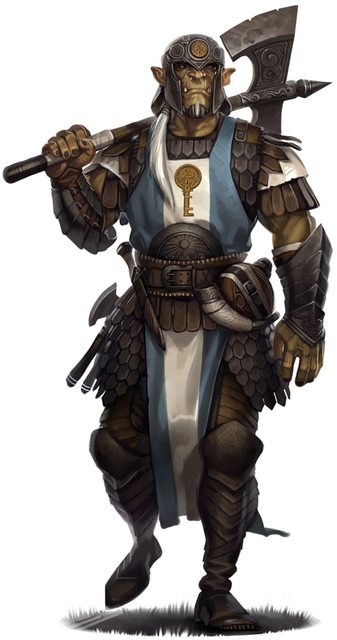
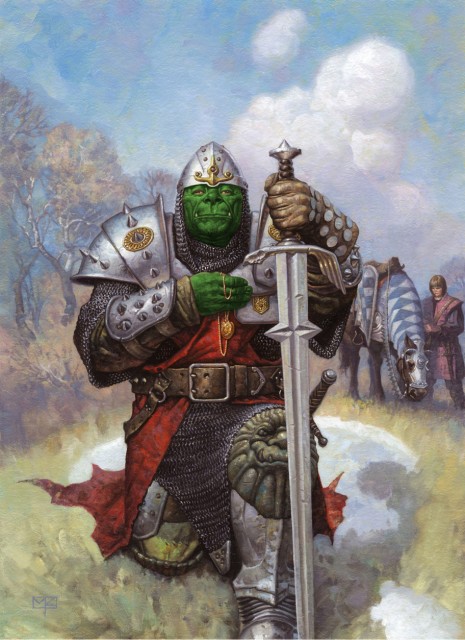
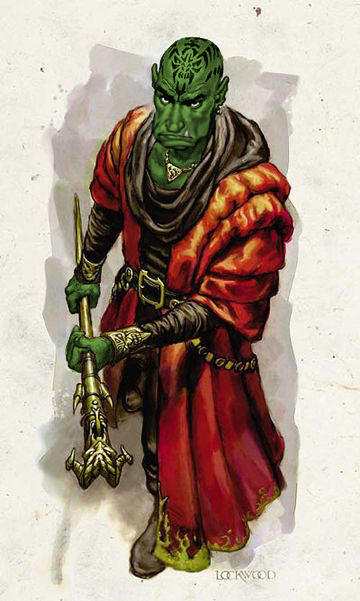
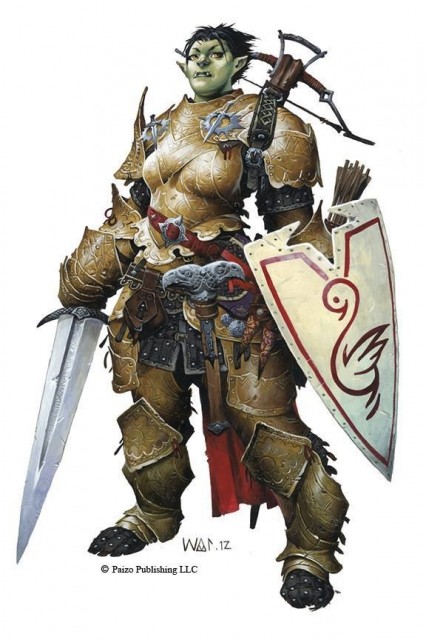
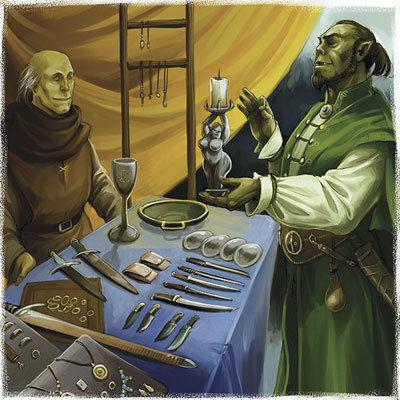

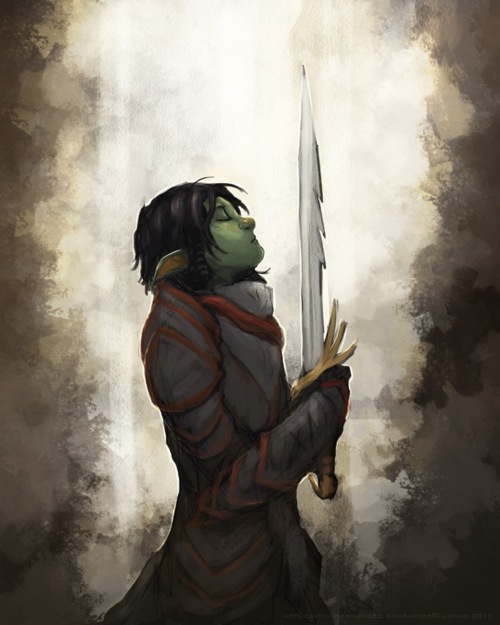
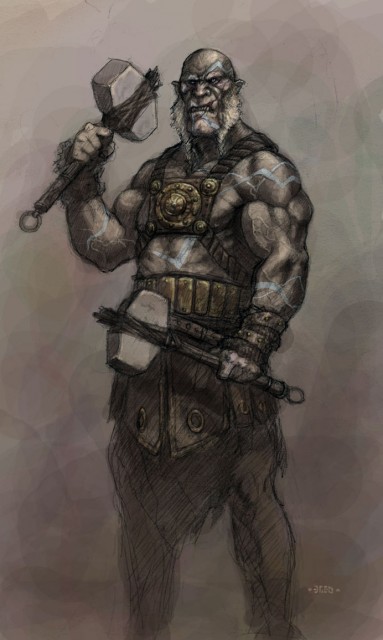

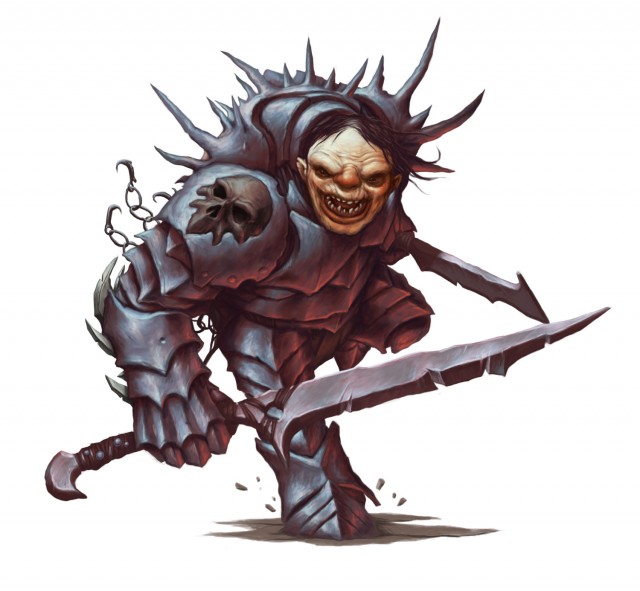
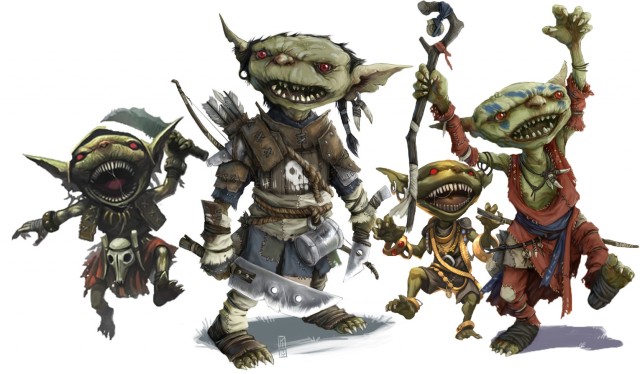
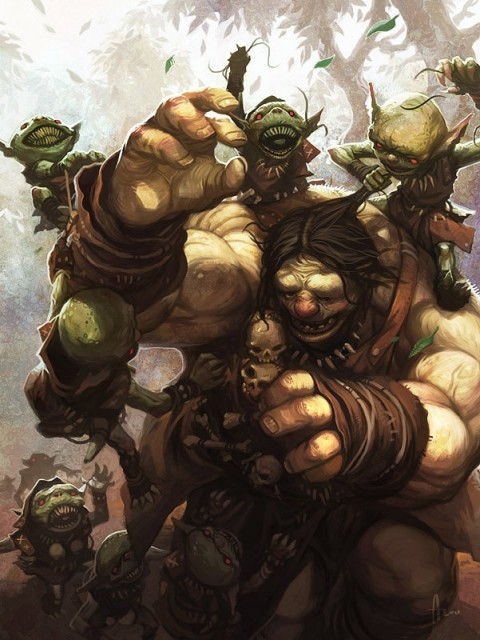
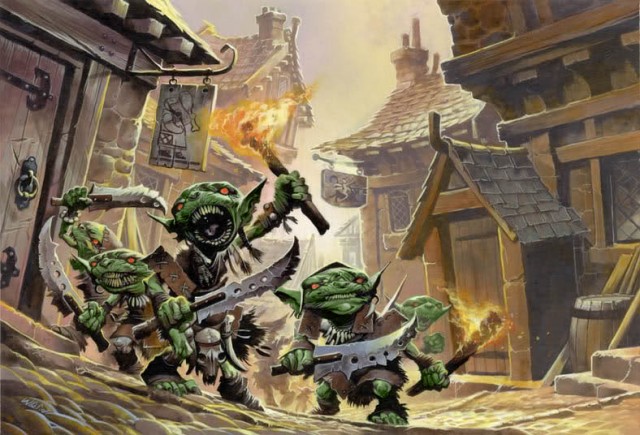
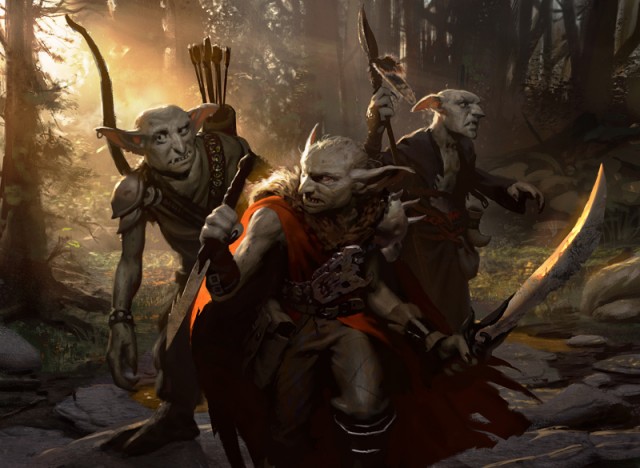
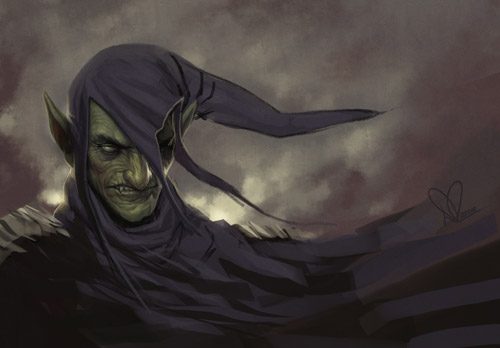
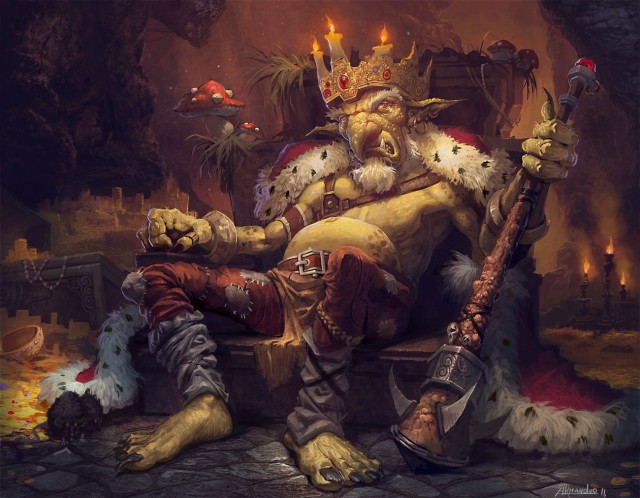
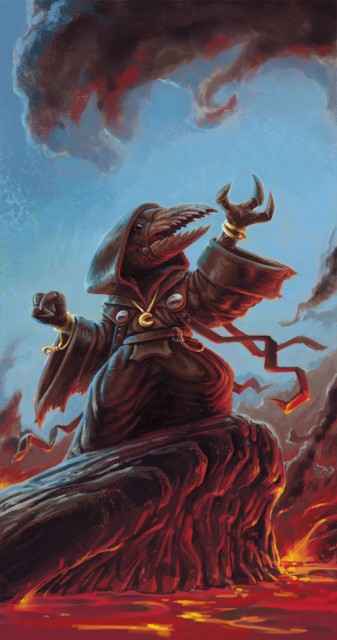

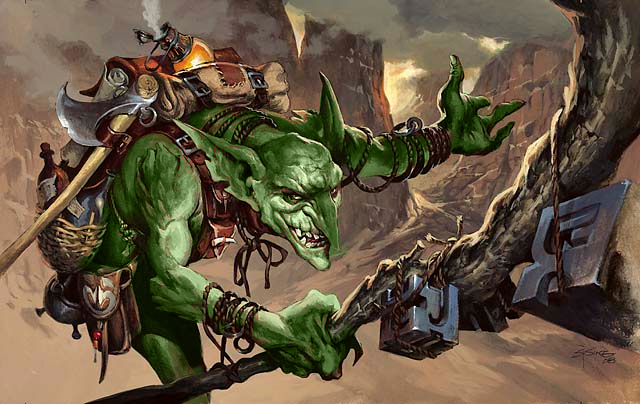
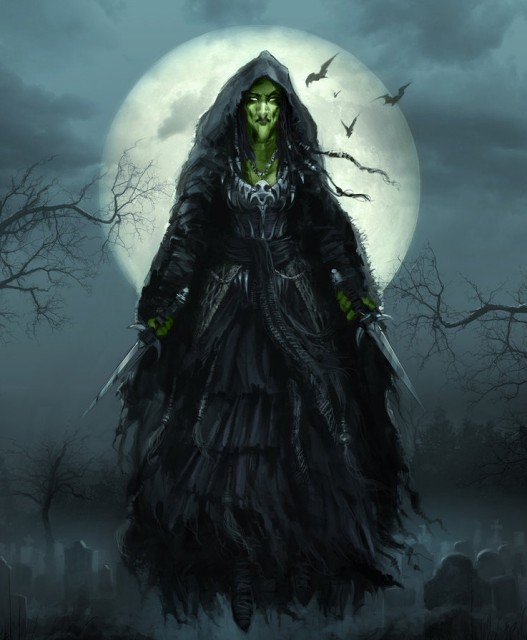
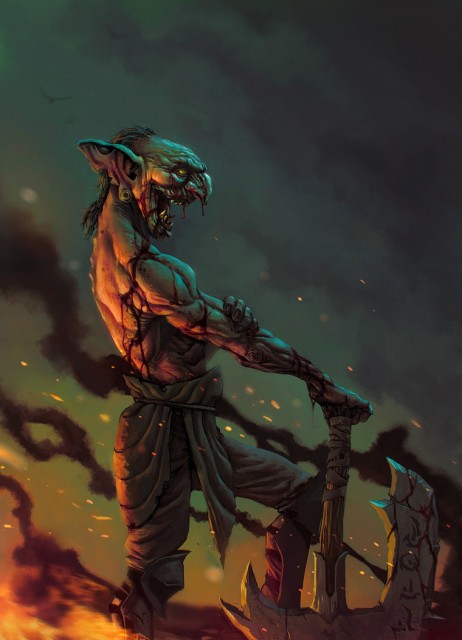
I loved reading these three articles, and all your other Reinventing Fantasy Races. You’re a genius, and really inspire me!
…please write a book.
Please?
These are always fun to read. You lost me a little bit with the Hoblites though – short lifespan and long childhood seems like an unlikely pair of things to have evolved together. Especially if it means they can get so distracted that they forget to reproduce.
@ Aimee:
Thank you! Maybe I will NaNoWriMo one year. I always toy with the idea of doing it, but I usually end up talking myself out of it. I love world-building and I can do it at a drop of a hat, but that’s actually the easy part of writing. Creating compelling characters, and devising stories that make readers care about them is incredibly hard. :)
@ Matt`:
That’s actually a really good point. I added a bit about communal child rearing to the article. I guess the idea would be that some members of the society devote themselves to child care, to free others up to do more important things. I also bumped down the length of their childhood a bit.
Thanks.